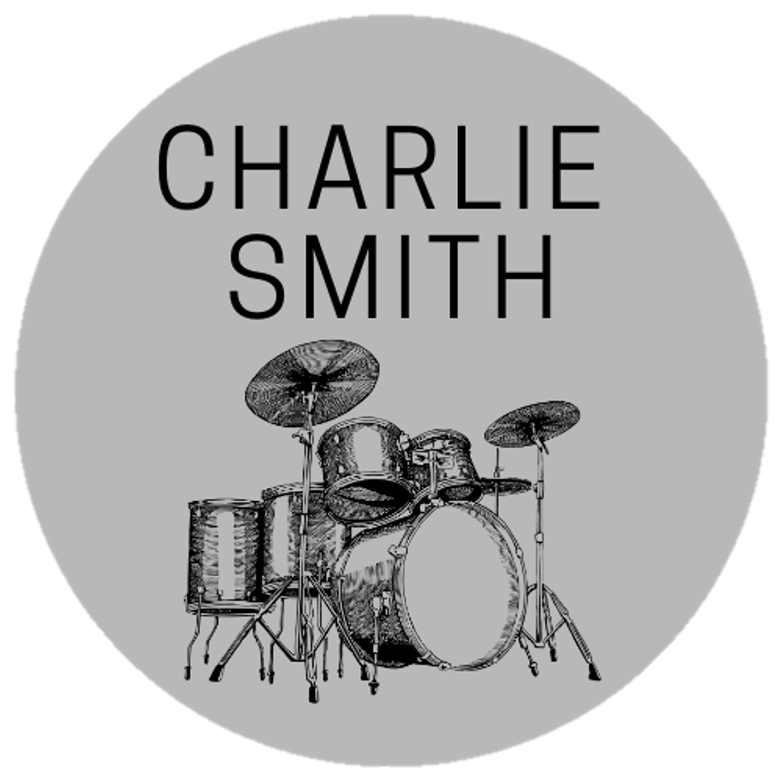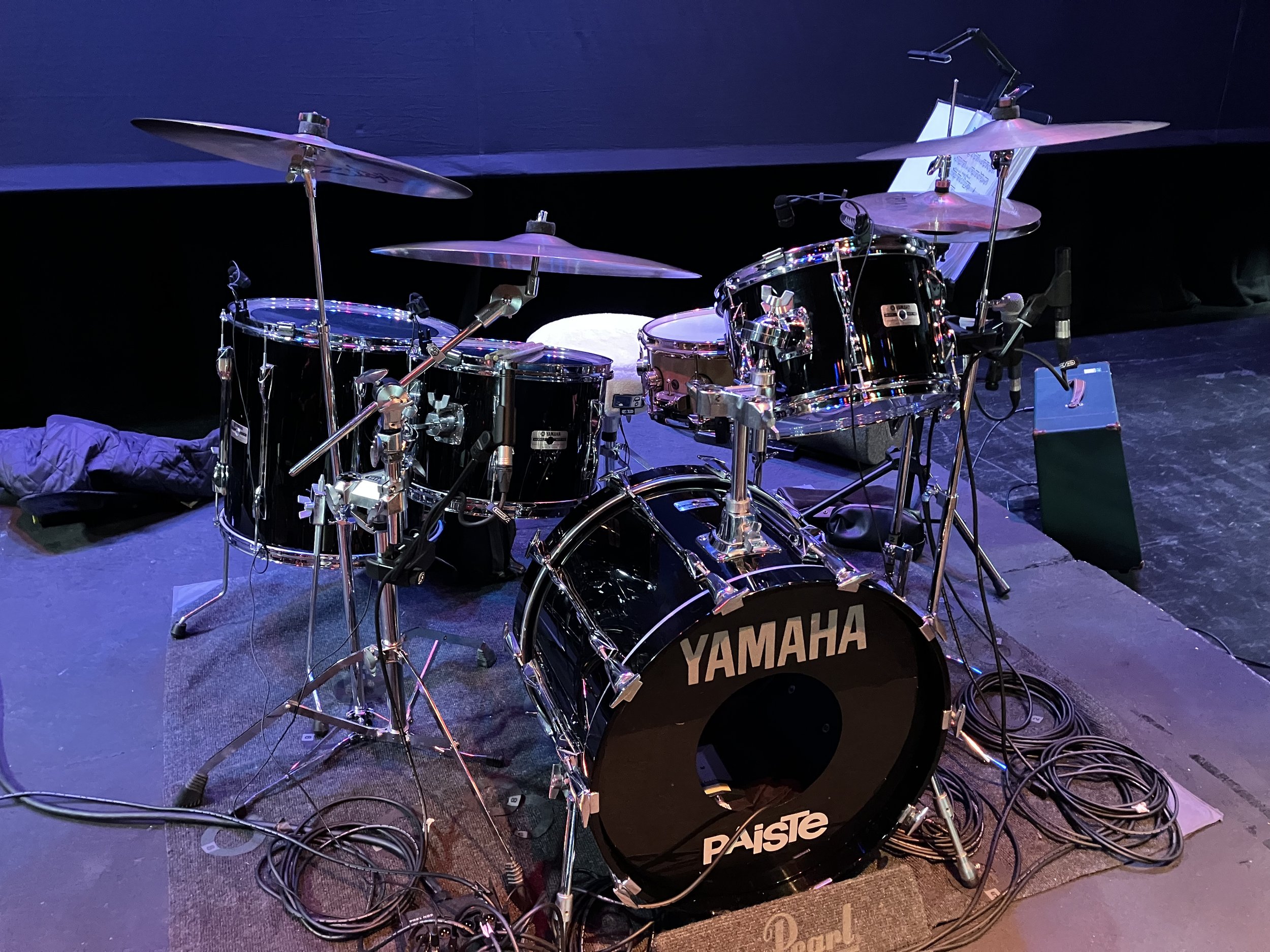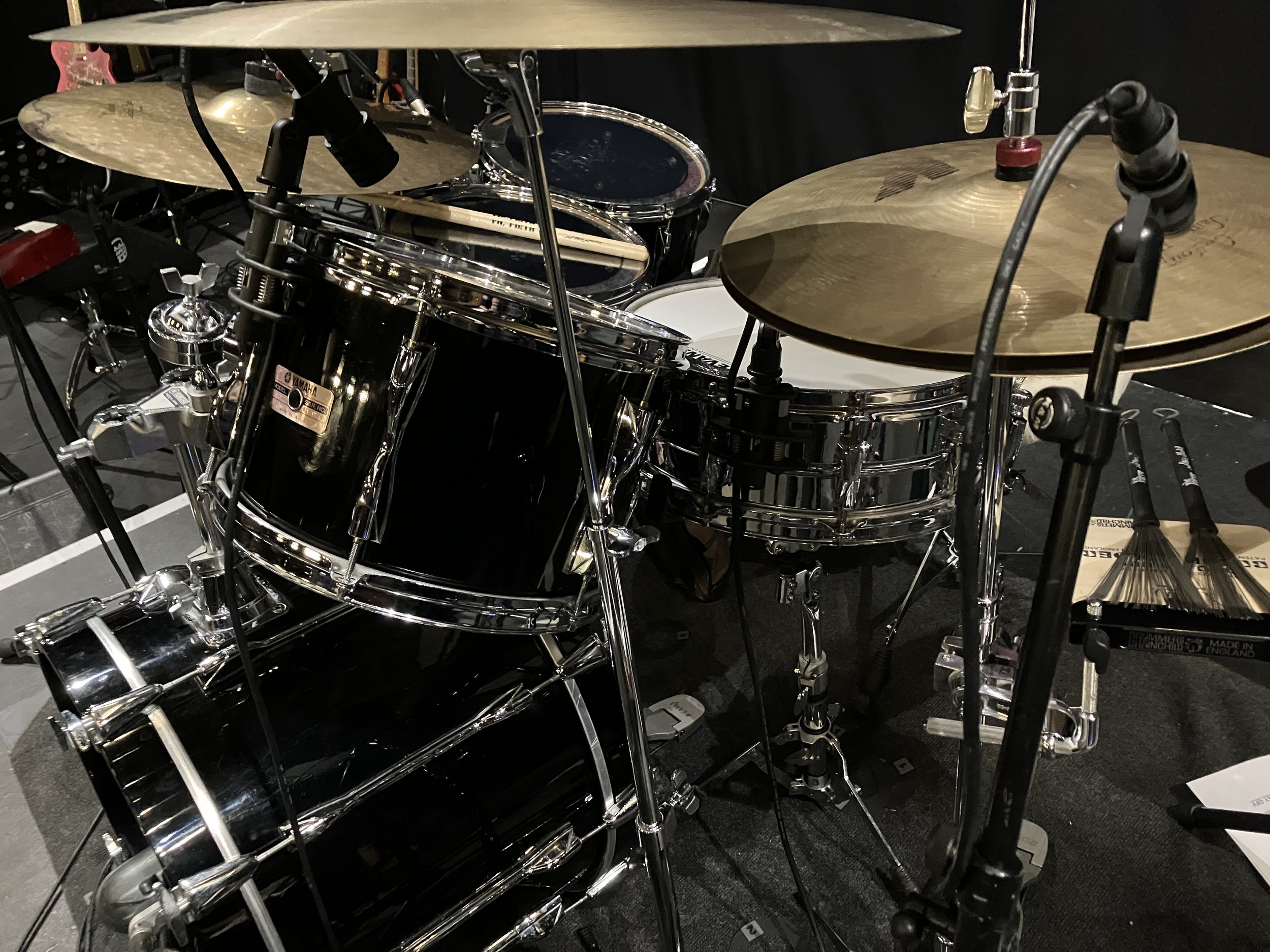The Dream Drums
Sat behind one of my all time dream kits, read on for all the details! (Photo: Keith Belcher, The Live Room, Saltaire)
It’s been a couple of months (time flies when you’re busy with gigs!) but there’s been some pretty major additions in the gear dept between August and now, and a few big boxes on my gear bucket list have been ticked!
The Recording Custom
Gadd’s mid 80’s RC Kit
Lets get the big one out of the way first, the mighty 80’s Yamaha Recording Custom kit. Bit of backstory first; these kits are synonymous with the best session players of the 70’s and 80’s, think Gadd, Erskine, Weckl, Colaiuta et al. Introduced as the 9000 series in 1975, with Japanese Hokkaido Birch shells, full length high tension lugs and a signature sound. The design was refined a little over the next few years and the Recording Custom name came about in the early 80’s, the following decade of production is what some consider to be the best era of these drums, before the YESS suspension tom mounts were introduced (Known as Pre-YESS).
The day the kit came home!
Now for me, the first time I really heard a 9000 kit on record was the power depth (deep toms!) kit Pete May was playing on the ‘Hank Play’s Live’ album and DVD with Hank Marvin, recorded in the mid 90’s. I first saw that aged about 5 and still love the playing and the sound of that gig. Later on getting into Steve Gadd and his incredible back catalog, obviously the RC’s are a sound I really came to know and love, and it says a lot that its mostly what Gadd has consistently played for over 40 years. So i’ve always lusted after an old 9000 kit, specifically an 80’s era kit with shallow sizes, smaller 20” bass drum (my personal favourite size) and of course in the solid black lacquer finish, because thats what both Gadd and Pete May had, and to me its always the colour I think of when I think of Recording Customs. So the quest to find a kit started!
Time travel to 2023, and i’ve been keeping an eye out for that dream kit for around 5/6 years, missed a couple along the way and been really sticking out to get exactly what I wanted (I saw so many power tom kits, and shallow size kits with big bass drums come and go, as well as the more modern iteration of the RC!) and I finally happened upon a listing for this kit on Facebook, all 1985-8 era drums but not factory matched, with a 10x8”, 13x9”, 16x16” and the real diamond, the elusive 20x14” bass drum. The photos really didn’t show it off too well, and it was a couple of hours drive out to go and see it, but the price was good and it was worth a punt, so I organised a viewing the next day. A few hours drive, and scaling half way up a big hill (though it felt like a mountain!) I was able to give it a thorough inspection, get the battered old heads off and see how it was in the flesh. It was covered in a thick layer of dust but I could see there was a diamond of a kit in there, and it had to come home with me!
The search was now on for the other sizes I wanted, specifically a 12x8”, 14x10” and 15x12” hanging toms. The 12” came pretty easy, as one just happened to be on eBay the day I picked the kit up, so without a moments hesitation I ordered it. Next was the 14”, which came about thanks to a nice guy in Slovenia in the Yamaha Drum Closet Facebook group who kindly got exactly the drum I was after shipped over. The 15 has been more of a challenge, but thanks to a guy in Australia who gave me a tip off to one in the USA on Reverb, one has just arrived to complete the kit. Each drum was treated to a thorough cleaning, polish and fresh heads, Remo clear Pinstripes for the classic RC sound (so much so that those heads were fitted as stock back in the day!), as well as a clear Powerstroke 3 on the bass drum, and the original resonant head replaced with a new Ebony ambassador (with a central hole of course for that classic look - thanks to Alastair Leigh for doing the logo job on there too). When the initial 10, 12, 13, 16, 20” was done, I set them up with the Yamaha Steve Gadd Birch snare for a quick impromptu sound test. Just filmed on an iPhone in one go with a rough tune up. The sound speaks for itself!
Soundcheck in Hull (Photo: Adrian Dunn)
Since getting the kit road ready, its been really busy, on theatre shows, functions and gigs with Martin Stephenson & the Daintees on the current tour, and having had the chance to try them in all different musical setting and hear them under mics in big rooms and intimate small venues, I really feel like this is a kit that everyone should own. They’re legendary kits for a reason, and yes they absolutely aren’t the cheapest and in the case of the old ones, they can be hard to get the sizes you want. But they’re well worth all of that, and so much more! Yamaha reissued the RC series back in 2016, in collaboration with Steve Gadd, making a few design tweaks and modernising them to match the current market. These are great drums too, but for me the US Birch just doesn’t compare to the Japanese Hokkaido birch of the originals, theres definitely something special in that timber! Anyway, enough waffling, enjoy some lovely pics of a lovely kit, oh and to hear about the snare, read on!
The Super Ludwig
Original 1958 Advert for the Super Ludwig snares.
Where do I start with this one, the Ludwig 400 model snare is arguably the most recorded snare in the world, and many know it in its seamless Ludalloy (Aluminium) Shell guise, as it has been since around 1963, but for those who know, there was actually another Ludwig 400 for a couple of years before that, the 1958-62 era Super Ludwig snares. These drums were offered from the last of the WFL era, through the trans badge and finished when Ludwig started serial numbered Keystone badges in early 1963. Initially offered in Lacquered and Chromed finishes, both over rolled and welded (not spun seamless like the more common aluminium shells) brass shells, with chrome on brass hoops, and all of the standard Ludwig fitments of the time. The 400 and 402 models were the chromed drums, in 5” and 6.5” depths respectively, while the 401 and 403 were the 5” and 6.5” Lacquered brass.
Kenny Clare’s WFL 401 (Photo: Neal Wilkinson @Nealdrums)
I was first tipped off to these drums a few years ago when I first met Neal Wilkinson and heard the incredible story of the 1958 WFL 401 that he has, which was previously owned by 60’s session legend Kenny Clare, and has been used on hundreds of sessions by both owners! When I heard Neal’s 401, I instantly knew it was a sound I needed to add to my own arsenal, but those 401’s are incredibly rare now, and command a price of £4-5000 on average. Which is of course way out of my budget, and something i’d be scared to take out of the case, never mind take it out on gigs. That brings us neatly to the Chrome over Brass model, although still scarce, tend to pop up slightly more often and at a slightly more reasonable rate, this was the drum I started the search for. Enlisting some pals in the industry on both sides of the pond to keep an ear to the ground for any Brass 400’s that were hitting the market, and after many months, a couple of very near misses scoring drums, I finally located a drum in Florida, and had it shipped over to Blighty. When it arrived it was in dire need of some love, so it was dispatched straight to Mark Haynes at The Drum Bunker, who is my guru for all restoration work on my vintage gear. He did a pretty stunning clean up and polishing job, replaced the ropey P83 throw off for the modern Ludwig P88 model (much more reliable for the amount of use this drum will get) and had the drum heading back to me in time to hit the stage on some theatre gigs and this Autumn’s Daintees tour. These photo’s from Mark’s bench speak for themselves! (The first is the before shot!) To surmise, it’s a 1960-62 Pre Serial badge era (post WFL/Trans badge) rolled and welded Chrome over brass shell, with crimped snare beds. 10 Imperial Lugs, P88 snare strainer and P32 butt plate, the small knob internal muffler and triple flanged chrome over brass hoops.
The snare was given a thorough play in my home studio for a few weeks to play around with some tunings and really dial it in, fitted with Evans heads top and bottom, and 16 strand Canopus snare wires. It is easily one of the nicest and most versatile drums i’ve ever played, such a wide range, from low swampy, to really poppy and tight sounding when cranked up a bit. Setting it in the medium high range for me is the best all round sound. Appropriately the first gig I took it out on was depping on a Back to Bacharach show at Darlington Hippodrome, and it got nothing but compliments from the Sound engineer, and sound sounded great on stage, especially playing some of the tunes of the same era this drum was made.
In the months since it’s done some more theatre gigs as well as a 10 gig run with Martin Stephenson and the Daintees on tour last month, and it’s sounded consistently wonderful in all manner of rooms, from big rock venues and concert halls down to intimate, smaller rooms. Suffice to say this dream snare lived up to all the hype, and has delivered everything I could ask for. As a friend said to me not too long ago, ‘thats a drum that’ll do any gig and sound great‘. I couldn’t have put it any better. It’ll be heading with me into the orchestra pit for panto for the next 2 months or so, so i’ll really be playing it a lot!
Hope you’ve enjoyed this article as much as I have putting it together, a bit of history, some stories and plenty of pictures of some wonderful instruments that are being used as they should. Just two of the many ‘bucket list gear’ items i’ve ticked off my list lately, and things that will be mainstay’s in my collection for a long time to come. Who know’s, maybe i’ll do another blog like this sometime down the road! If you want to see more of my gear, head over to the Equipment page of the website.


























